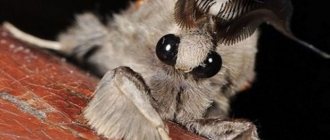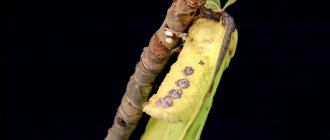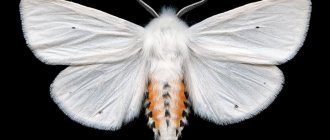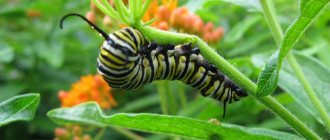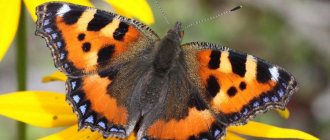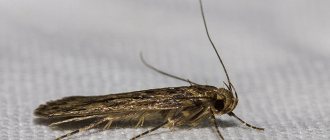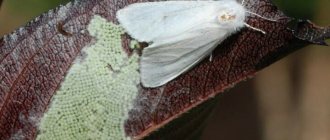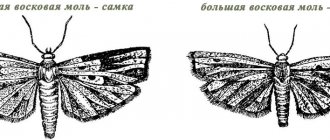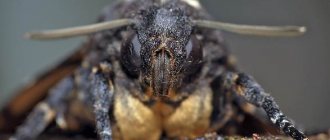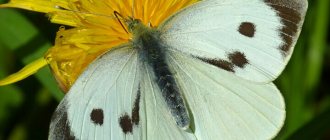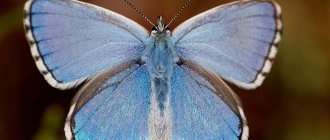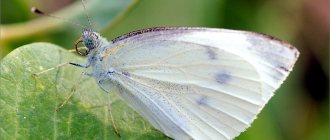It would seem that the meadow moth, in accordance with its name, should flutter on lawns and meadows. But no, the natural spaces do not attract him. The insect tries to stay close to agricultural lands and occupies plantations of sunflowers, sugar beets, legumes, cereals, vegetables, and melons. Polyphagous behavior, rapid reproduction, long-distance migrations and cyclical outbreaks of increased population growth place the meadow moth on the pedestal of the most dangerous and insidious pests of fields and vegetable gardens.
What does a meadow moth look like?
The meadow moth is a typical representative of the grass moth family. The habitat covers almost the entire forest-steppe zone of the post-Soviet space. The most favorable regions for development are those with a moderate, warm climate where precipitation is stable.
Appearance
The description of the meadow moth has much in common with its relatives:
- nondescript color of light brown or yellow shades;
- wingspan from 17 to 27 mm, when folded they have the shape of a triangle;
- the front wings are gray-brown with a yellow pattern;
- the darker hind wings are bordered by parallel stripes;
- forehead with a conical protrusion;
- thin thread-like antennae in females and serrated antennae in males.
Meadow moth butterflies exhibit pronounced sexual dimorphism. Females are larger than males and have a thick abdomen. In the latter, the body is thinner and longer; when you press on the abdomen, a brush of hair appears at the end, while in the female it looks like a fan.
The length of the eggs does not exceed 1 mm. Elongated shape. The color is yellowish with mother-of-pearl.
The hatched larva is transparent yellow or greenish in color. As they grow older, the color becomes more saturated and almost black. An adult meadow moth caterpillar grows up to 3.5 cm. Two stripes can be distinguished on the back, and elongated shiny lines on the sides. 8 pairs of legs provide the larva with good mobility.
The length of the pupa is 12 m. The color is light brown, becoming gray before the butterfly emerges. The cocoon is usually found in the soil and covered with lumps of dirt. On the top there is a special hole, slightly covered with cobwebs, from which a young moth will fly out.
Conversion process
Depending on the climate zone, as well as the type of insect, the process of degeneration can take from 2 days to 14 years. In our regions this process takes up to 2 weeks.
The transformation process itself is called metamorphosis, or more precisely, holometamorphosis, since the larva does not transform completely and some parts remain from it, mainly the paws. This term characterizes the complete transformation (degeneration) of forms, just as a glass or other forms are obtained from a melted bottle, which are radically different from the shape of the bottle.
Although the cocoon always remains motionless in appearance, quite complex and unique processes take place inside it. The caterpillar's body acquires a liquid consistency with imaginal discs, which essentially represent stem cells. These cells are unique in that they subsequently form various tissues and organs of the moth.
When the process is completed and the butterfly is already in the cocoon, it secretes a special substance that allows it to get rid of the cocoon. The head emerges from the cocoon first, then the body, and finally the legs. After birth, the butterfly sits motionless for some time and waits for its wings to dry. After which she goes on a journey to find herself a representative of the opposite sex. After mating, the butterfly will lay eggs, from which larvae will appear, etc.
Amazing transformation
Watch this video on YouTube
Subtleties of life
In the photo, the meadow moth is the cutest creature, looking at which you wouldn’t even think that it is a malicious pest and a menace to farmers. In principle, it is not the butterfly itself that is harmful, but its offspring. But first things first. Insects overwinter in the caterpillar stage in a cocoon, which reliably protects them from the negative influences of the external environment.
On a note! Overwintering larvae are very resistant to low temperatures and retain their vital functions at minus 30°C. However, in the spring they become susceptible to even minor frosts, which can kill them.
Individuals that survive the winter pupate. The first generation of meadow moths begins to fly at the end of April. In the northern regions, the time of departure of butterflies is noted in early June. Insects are active during twilight and night hours. Daytime is spent in the grass, under leaves. Meadow moths are very shy. At the slightest rustle they show a feeling of anxiety and take off.
Females need food to reproduce. Nectar serves as their food source. But there is one more nuance that affects the development of the population. If during the life of the meadow moth caterpillar there was not enough liquid in the diet, then the female may be infertile or produce few offspring. Drought can provoke insects to migrate.
Meadow moths travel long distances in search of food or moisture. Such migrations are called active. But there are also passive migrations, when moths move through air masses. The migration capacity of butterflies reaches 300-900 km.
Peacock-eye Atlas
It is worth noting that female Atlas Peacock-eyes are much larger than males. Individuals feed on leaves of bushes and trees. And like previous record holders, they lead a nocturnal lifestyle. They are especially active during twilight, early morning and late evening, which is why they received the nickname “Prince of Darkness.” And the best way to observe the largest butterflies in the world is not in person, but in photographs. However, residents of Russia can see the beauty without leaving the country - Atlas Peacock-Eyed is bred in the Moscow Zoo.
By the way, the Atlas Peacock-eye species itself is quite interesting. During mating periods, a male can detect a female at a distance of up to several kilometers. And the mating itself lasts several hours without interruption. Immediately after emerging from the pupa, both the male and female are ready to reproduce. Peacock-eyes are unusually patient; females can wait for their male for several hours, while sitting motionless in one place, while the male will look for her at this time. And it is precisely this process, that is, reproduction, that is the meaning of life for the largest butterfly in the world. By the way, the life of a female is quite short. She dies immediately after laying offspring.
By the way, in Taiwan, Peacock Eyes without knowing it benefit people. People use caterpillar cocoons as wallets.
The largest butterfly in the world amazes with its beauty. The winged individual can be colored in bright red, yellow, pink and brown shades. And on each wing of the butterfly there are large triangular transparent “windows”. The front wings have a rather bizarre curved edge, which in shape and color resembles a snake's head. This is what the Peacock Eye scares away insectivorous animals. By the way, in Hong Kong, for this unusual feature, Atlas was nicknamed “The Moth - the head of a snake.”
In addition to its size, Peacock-Eyes has one more feature - its mouth is completely atrophied. Throughout its short life (only 1-2 weeks), the butterfly does not feed on anything, but processes all the fat reserves that it accumulated as a caterpillar.
By the way, the caterpillars of the giant butterfly are also huge - they grow up to 10 centimeters in length. And their appearance is original - they are light green in color with large blue processes throughout the body, which are covered with a waxy white coating (similar to powder).
Peacock-eye Atlas is not only a beautiful, but also a useful butterfly. In India, it is bred on special farms where fagar silk is obtained. It differs from the silkworm product in its wooliness, strength and durability.
Reproduction nuances
Under the accompanying optimal conditions: availability of food, moisture, temperature from 20°C, sexually mature individuals begin to mate. As a rule, egg laying begins 5-7 days after the butterfly leaves the cocoon. The female places eggs on the inside of leaves, on weeds, stems, and less often on dry residue or soil, 5-20 eggs each, stacking them on top of each other, like tiles. The process of laying offspring lasts 1-2 weeks.
The fertility of a female meadow moth reaches 600 eggs and is determined by the quality of the caterpillar's diet. It has been noticed that, under the same meteorological conditions, those individuals that ate beets are more fertile.
At a temperature of 27°C and a humidity of 75%, embryonic development lasts from 2 to 15 days. In hot weather, when the thermometer is above 30°C and the humidity does not exceed 45%, almost half of the eggs die. The young larva of the first instar feeds on the tissues of leaves from the underside, forming peculiar “windows” on them.
Young individuals of the first instar do not touch cereal crops. If any caterpillar is tempted by corn, this will lead to its death. Older individuals, starting from the third instar, consume grains without harm to their health and these crops no longer pose a threat to their life.
Adult caterpillars unceremoniously eat various crops, the list of which includes 200 different types of vegetation. After their invasion, skeletonized leaves with visible veins and entwined with cobwebs remain. During mass invasions, cuttings are also eaten. Roots, shoots, and fruits are damaged.
The development and life of the meadow moth caterpillar depends on many factors. For larvae of the first instars, moisture is very important; at older ages, the need for nutrition increases. The larvae are distinguished by their mobility. In search of food, they easily overcome 50 meters; in forced situations, they migrate to longer distances.
The feeding of the larvae lasts about 15-30 days. After which they burrow into the ground, weave a cocoon and pupate. After 14-0 days, new butterflies appear, ready to mate and increase the population size. From 1 to 4 generations are possible per year. The larvae of the last generation go to the ground for the winter.
Winged pests in garden beds
Vegetables occupy a significant place in the human diet. The balance of our diet depends on their quality and quantity. And any summer resident always wants to get rid of butterflies in the garden in order to preserve the harvest in full.
Fall armyworm
With the onset of dusk, the active summer of the winter armyworm begins. To lay eggs, dark brown females choose plants in open spaces; butterfly clutches can be found on strawberries. During a season, one individual can lay up to 2000 eggs (10-30 eggs in one place).
The development of caterpillars takes 24-30 days, after which they burrow into the ground. By digging a depression up to 6 cm, they pupate. The second generation caterpillars also overwinter in the ground (up to 20-25 cm). After the soil warms up, they rise to the surface of the earth. Mass emergence of butterflies is observed in May.
Acacia moth (legume)
A light yellow butterfly with medium-sized fore wings (span - 25-30 mm), the hind wings are grayish in color. The female moth lays 100-600 greenish-yellow eggs. In 110-120 days of life, the acacia moth manages to make 2-3 clutches. After 4-21 days (depending on the generation), caterpillars with pink bodies and a yellow shield appear.
Depending on the air temperature and nutrition, the caterpillars develop within 20-40 days. Pupation occurs on the ground, sometimes caterpillars form cocoons at a depth of 2-5 cm, strengthening them with particles of earth. Moth moths appear after 12-15 days.
Onion moth
A small butterfly of light gray or chocolate color with wings measuring 11-15 mm. The female lays 60-80 eggs in the area of the neck of the onion or on shoots. A week later, caterpillars appear, eating the inside of the onion.
After 15-20 days, pupation begins. During the growing season, usually 2-3 generations have time to mature. The age of onion moths is observed after 10-20 days.
Cabbage scoop
The spotted gray-brown wings of the cabbage cutworm reach a span of 35-60 mm. It flies mainly at night. At the same time, the female lays 40-60 (up to 700 per season) eggs.
Adult caterpillars (body size up to 25-30 mm) are ready for pupation. They make cocoons by burrowing 8-10 cm into the ground. In the spring, the butterfly flight begins.
Cabbage moth
The sickle-winged butterfly with wings of 15-18 mm causes great damage to field crops. The light brown female lays 100-300 eggs, grouping them in groups of 4-5. A week later, caterpillars appear, which molt 3-4 times during their development. In search of fresh greens, they can crawl into beds with radishes.
Adult caterpillars (body length - 11 mm) pupate, attaching a cocoon to the back of the leaf. The moth's flight begins in 35-40 days. During the summer season, (depending on the climate) from 2 to 10 generations of cabbage moths can develop.
Cabbage white (cabbage)
Large butterflies with powdery white wings (span up to 60 mm) and dark rims along the edges. The females have large black spots on their wings. Female individuals lay 100-300 ribbed, lemon-yellow eggs.
The voracious caterpillars appear on days 6-8; they often crawl onto neighboring plants. Before the butterflies emerge, they remain in the chrysalis for 8-17 days. During the summer season, 2-4 generations of cabbage may appear.
exclamation scoop
A large butterfly (body length 30-40 mm) with large brown-brown wings (span 32-45 mm). The color of the male is lighter - from yellow-brown to gray-yellow. At the top of the wings there are two round black spots, at the base there are wedge-shaped wide stripes, the outlines of which resemble an exclamation mark.
The female lays eggs on fallen leaves. The eggs are ribbed, translucent with a greenish tint (diameter 0.7-0.9 mm). After 12-14 days, yellowish-white caterpillars appear (the length of an adult is 30-40 mm). Over time they turn red. A black stripe stretches along the back, which forms small triangles on each segment of the caterpillar's body.
Yellow-brown pupae (cocoon length - 12-14 mm) are equipped with sharp spines, and there are two tubercles on the sides. They overwinter in fallen leaves or in the surface layers of the soil. The adult caterpillars (4th-5th generation) remaining for the winter can go deeper into the surface layers of the soil (up to 10 cm); the butterfly flight begins at the end of May.
Maliciousness
During mass dispersal, harm is caused by both adults and caterpillars. Numerous flocks of meadow moths become competitors to honey bees, which is not something any beekeeper can be happy about. The amount of honey in the hives is significantly reduced.
Caterpillars of the first generation eat weeds along roadsides, in ravines, and in forest belts. The voracious larvae of the second generation of the meadow moth infect sunflower, alfalfa, buckwheat, sugar beets and other agricultural and forest crops. Depending on the number of pests, the crop can be reduced by 50%, or even completely destroyed.
On a note! The threshold of harmfulness of the meadow moth on sunflower is 10 caterpillars per 1 sq. m in the seedling phase up to 6 leaves. During the flowering period, the figure increases to 20 caterpillars per square meter. m. A similar threshold of harmfulness is typical for sugar beets. Only what is taken into account is not the flowering, but the closing of the leaves.
The larvae with an insatiable appetite destroy all vegetation in their path. In their gluttony they are not inferior to locusts. It is also noteworthy that, like the latter, the meadow moth is characterized by an outbreak of mass reproduction, which occurs cyclically with an interval of 10-12 years. It has not yet been possible to unravel the reasons for this phenomenon. It is possible that some of the main factors are climatic conditions, mass migrations of the meadow moth, and solar activity. Interestingly, the ability to migrate helps butterflies to avoid natural enemies and parasitic individuals.
Features of biology
The lifespan of adults is 4-20 days. Butterflies are active at dusk. One generation develops in the Non-Black Earth Zone; two generations - in forest-steppe and northern steppe regions, in Siberia and the Far East; three or four generations develop - in the southern steppe regions, in the North Caucasus and Transcaucasia.
The flight of butterflies is observed at different times depending on the area of the range and is often extended: adults of the overwintered generation fly in May-June, the first generation in June-July, the second generation in July-August, the third and fourth generations in August-September .
Stages of development
The larvae hatch from tiny eggs after a week-long developmental stage. They are already millimeters long and have eight tiny legs on a white body with a yellowish head. As they feed, their size increases to almost twenty figures! And upon reaching the age of one month, the moth larvae turn into dolls, approximately one and a half centimeters in length.
An adult pest enters the beehive during daylight hours. But it conducts its guerrilla activity of laying eggs exclusively at night. The bees independently fight against the occupying invaders, and without much effort. But in just a few hours the number of such parasites becomes quite large, so here and there some people are still overlooked.
However, such pests are used to make useful extracts that have no less healing power than bee products.
Crop protection system
Measures protecting agricultural crops from damage caused by the meadow moth and its larvae must take into account the destruction of both local individuals developing in the field and emerging butterflies from outside.
Developing local pests are best destroyed using agrotechnical measures, supplemented with chemical and biological preparations. The vagrant meadow moth on corn and other crops is mainly exterminated by chemical means.
In order to make the right decision regarding the measures to be applied, periodic assessment of the phytosanitary situation is necessary. It is best to do this in the fall, during the period of field survey, and again during the flight of butterflies. During the period of mass reproduction, the ecological situation and population size of the meadow moth should be carefully monitored.
High fertility of females occurs when environmental conditions are as close as possible to ideal for this type of parasite: hot daytime temperature (about 25º C), good air humidity (more than 65%), periodic rains and a lot of nectar plants.
During the egg-laying period, it is advisable to constantly weed and mow weeds, as well as loosen the soil between the rows to reduce the number of eggs laid. If the flight of adult individuals exceeds 5 pieces per step, the use of insecticidal and biological compounds is necessary.
Reasons for the appearance of the house
A moth cannot appear out of nowhere. There are several main ways pests can enter a house or apartment:
- food moths can be brought with contaminated products (there may be eggs or larvae of the pest in flour or cereal);
- Moths can be contaminated with used furniture, carpets, and second-hand clothes;
- the insect can also get into the house on new clothes if pests live in the store or warehouse;
- through the ventilation duct from the neighbors.
Another option is that moths fly in from the street through a window. However, given that insects do not fly well, such cases are extremely rare.
Folk remedies for fighting butterflies
You can also destroy or repel garden pest butterflies using harmless homemade products.
| Means | Mode of application |
| Hemp, calendula, thyme | Plants are planted under fruit trees; Butterflies are repelled by the strong smell. |
| Composition of salt and shag | Spray the fruit trees with an aqueous solution (800 g of table salt and 400 g of shag are combined with 10 liters of water, infused for 24 hours). |
| Yarrow decoction | Dry grass (250 g) or fresh plants (200 g) are poured with 2 liters of water, after boiling, cook for another 5 minutes, cool and strain. Add water to 10 liters and spray. |
| Infusion of dry calendula and garlic seeds | Finely chop or crush 100 g of garlic and mix with 4 cups of flower seeds. Infuse the mixture in a bucket of cold water for 3 hours. Spray plants after sunset. A month before harvest, stop using the mixture. |
| Decoction and infusion of wormwood | Chop 3 kg of fresh (600 g dry) herbs, leave for 24 hours in 10 liters of cold water, then boil for another 30 minutes. Grind 5 cups of fresh herbs, pour 10 liters of boiling water and leave for 3 hours. The last treatment of plants with wormwood preparations is 1 month before harvest. |
Habitat
Night moths live in almost all corners of the globe, both on continents and on oceanic islands. The only exception is Antarctica, where the climate is too harsh for these gentle creatures. Most often, moths can be found at night near the place where there are food plants suitable for a particular species.
By the way, not only what the moth eats depends on its habitat, but also how long it lives. In regions with cold and temperate climates, insects often live shorter lives than in the tropics, although life expectancy is primarily determined by species. The presence of natural enemies also affects this period. Among those who eat moths:
- birds;
- insect predators;
- insectivores.
Moths can be found not only on the plains, but also in the mountains. Insects can exist at altitudes of up to several thousand meters above sea level.
How to get rid of moths and their larvae?
Both traditional recipes and chemical preparations will help you get rid of moth larvae. Many housewives take advantage of the fact that moths are quite sensitive to temperature changes. Knowing at what temperature moths die, you can treat things and products to destroy pests.
Adults die at a temperature of -2⁰С, moth larvae at -10⁰С. If we talk about high temperatures, readings of +40⁰С are destructive for imagoes, and +50⁰С and higher for larvae.
Attention! Washing things in hot water or treating them with a steam generator, or heating the cereal in the oven will help get rid of pests. Another option is to take things out into the cold in winter and put the food in the freezer so that the insects freeze and die.
You can fight moth larvae using insecticidal preparations, such as:
- sprays;
- gels;
- emulsions.
Fumigators and traps are also used.
Attention! Strong odors are what moths and their larvae are afraid of. Therefore, folk remedies for pest control are essential oils, plants, and herbal decoctions.
The most commonly used insect repellents are:
- dried citrus peels;
- essential oils (eucalyptus, lavender, lemon, mint, grapefruit, fir, orange);
- herbs (wormwood, rosemary, tansy);
- ammonia, vinegar.
Attention! Moth larvae cannot tolerate sunlight. In order to get rid of them, things can be taken outside or onto the balcony in clear weather.
Prevention of occurrence
Preventing moths is easier than trying to deal with existing pests. For prevention purposes, you should follow a few simple rules:
- do not make too large stocks of cereals, pasta, nuts and other products that moths feed on;
- Store bulk products and dried fruits in hermetically sealed glass or metal containers;
- regularly ventilate wardrobes with clothes and kitchen cabinets; it is very advisable to ensure that sunlight enters the wardrobe (you can use an ultraviolet lamp);
- Before storing seasonal items, they must be washed or dry cleaned.
Also, for prevention, you can have geraniums at home, and place sachets with herbs that repel pests or special anti-moth tablets on the shelves of the cabinets.
Scoop eggs
What do they look like?
The eggs are spherical or hemispherical in shape. The top is rounded, the bottom is flattened. The diameter varies from 0.4 to 0.9 mm. The color is most often light - it can be white, cream, light yellow, greenish, blue, pale brown.
The surface is usually ribbed and shiny, sometimes cellular. As they develop, the eggs may darken and change color. For example, bollworm eggs become almost black shortly before the larva emerges.
See photo for what cutworm eggs look like.
Where does it go?
The female hides the eggs, placing them on the ground, in plant debris, on the inside of leaf blades of food or weed plants. The shape of the masonry is irregular and asymmetrical. May be in the form of spots, winding rows and lines.
For additional protection, the female covers the eggs with her own hairs and scales or secretions of special glands.
What is the quantity in the clutch?
Female cutworms are famous for their fertility for good reason. One adult produces from 2 hundred to 3 thousand eggs during its short life. She lays eggs daily, placing them singly or in groups. A clutch can include from 2 to 150 eggs. The quantity depends on the type.
For example, the cabbage cutworm lays a clutch of 100 eggs, and the gamma cutworm lays eggs one or two at a time, with a maximum of 5.
Amazing creatures
Caterpillars and their butterflies are not always alike; the color does not at all match the color of the future moth. Some larvae have similar features - spots, streaks of identical color. Only specialists and obvious fans of these insects can determine from which caterpillars and which butterflies emerge.
- One of the most beautiful butterflies in our area is the peacock eye. The larva of this beauty is black in color with spines all over its body. The change in appearance is dramatic.
- Other black caterpillars will become wren butterflies.
- Amazing creation of bromeia. The caterpillar looks like a stick, and the butterfly has a very interesting woody color
- Green caterpillar with multi-colored pimples - cecropia.
- The black swallowtail has a simply irresistible color in green and blue tones. But there are also yellow dots on the caterpillar’s body.
- Dalcerida. It is not clear from the outside whether the larva will produce an insect or an animal. The appearance of the moth is no less unusual.
- The blue morpho is another creature that captivates with its appearance.
- Swallowtail is a butterfly well known in our area.
- The butterfly used to produce natural silk is the silkworm. She leads a sedentary lifestyle and practically does not use her wings for their intended purpose, despite the fact that their span reaches 60 mm. The larva forms a cocoon of silk threads up to 1500 m long.
We invite you to familiarize yourself with the buildings on the land plot
Peacock butterfly and its caterpillar
Do caterpillars that manage to survive to the pupation stage always turn into moths - yes. Transformation always happens. However, in nature there are other insects whose larvae are similar to caterpillars, but they are called worms. At the end of the development process, they are destined to turn into beetles, bees, flies, and wasps. Sawflies are very similar to the larvae of butterflies; they are called false caterpillars.
People never cease to admire some types of butterflies; they keep them in the house, creating favorable living conditions for them.
Butterflies and their caterpillars often differ in coloring, so it is quite difficult to understand at the caterpillar stage which moth it will turn out to be. Despite this, some similarities can be found on the body of the caterpillars, in the form of spots or streaks. Therefore, only specialists who study these amazing living creatures know which caterpillars belong to which butterflies.
Below are photos of butterflies and caterpillars, as well as their names.
- The peacock eye is one of the most beautiful and most common butterflies that can be found in our area. The caterpillar of this butterfly is black in color and has many spines on its body. It should be noted that there is a fundamental difference between a butterfly and its caterpillar.
- Black caterpillars similar in appearance will turn into butterflies - hives.
- Bromeas are quite interesting creatures, since the caterpillar has a stick-like appearance, while the butterfly has an interesting woody hue.
- The Cecronia butterfly comes from a green caterpillar that has multi-colored pimples on its body.
- The black swallowtail is distinguished by an amazing green-blue tint, while there are also yellow dots on the caterpillar’s body.
- Dalcerida is such a unique creature that it is not clear what kind of creature will come out of the caterpillar. The moth also has an unusual appearance.
- The blue morpho is a species of butterfly that has a rather attractive appearance.
- Swallowtail is a butterfly that is often found in our area.
- Silkworm. Thanks to this butterfly, man managed to obtain natural silk. When a butterfly larva forms a cocoon, the length of the thread is about one and a half kilometers. The butterfly rarely flies, despite the fact that its wings reach a span of 60 mm.
Peacock butterfly
There are species that are so beautiful and unique that people keep them in their homes, creating favorable conditions for them.
How does a caterpillar turn into a butterfly? | DeeAFilm
Ways to protect yourself from enemies
The moths of Russia, and all others, are created by nature in such a way as to have protection from ill-wishers.
A list of defense mechanisms of moths is presented below.
Construction of shelters: different subspecies of moths organize similar protective structures for themselves. For example, caseworms and bagworms. The caterpillars of these moths, some time after hatching, build houses around which they attach pieces of foliage and various debris.
These shelters are designed in a special way so that the larva protrudes from them just enough so that in case of danger it can quickly hide inside. The house grows with its owner, at least until she grows up and becomes a pupa (this size is approximately 4-5 cm). After the allotted time, the butterflies come out, but only if we are talking about males. The females stay in these houses longer, until they are fertilized by the male and lay eggs.
Defensive body structures, including hairs and glands, are also defense mechanisms for moths. Do moths bite, having such a formidable weapon? The answer is obvious: only if necessary.
Many caterpillars have a series of bristles or hairs that can burn with poison hidden in the skin glands. During an attack, a dangerous mixture is sprayed from the tip of the bristles, which irritates the skin of the enemy.
In addition, insects use the following means of protection:
- glands in the larvae, with the help of which they cover their own bodies with a liquid that repels approaching predators;
- individual individuals begin to actively move when the enemy approaches, or pretend to be dead, or curl up into a tight ball;
- the larvae, at the moment of approaching danger, can fall from the branches on which they live, hanging on thin silk threads (the individual returns back along the same thread, slowly moving along it with its legs located on the chest and oral appendages);
- hawk moths have dorsal growths that look like horns, which they point towards approaching danger;
- insects can defend themselves with the help of long, prickly hairs covering their body.
The pupae of moths, so helpless in appearance, also have mechanisms to protect themselves from a sudden enemy attack:
- pupae living in the soil are colored in colors that make them invisible;
- moths weave silk cocoons (in the silkworm, such shelters can have up to three layers - loose, dense and filmy), in which they hide from attacks by predators.
Beautiful and unusual entomofauna of the peninsula
The most beautiful insects in Crimea live not only in protected areas. Unusual specimens are found in parks, squares and even in private plots.
- Scolia giant wasp. The species is on the verge of extinction and is therefore listed in the Red Book. The size of the female reaches 5.5 cm. Against the background of a black body, wide purple wings and a bright yellow sternum look impressive. The entire body is covered with black and red hairs. The insect not only has beautiful bright colors, but also an extraordinary lifestyle. Scolia larvae parasitize the larvae of rhinoceros beetles, as well as beetles. The insect builds numerous tunnels in the soil, looks for a victim, paralyzes it and lays one egg at a time. So the offspring of Scolia do not experience a lack of nutrients, gradually eating away the insides of the host, consuming vital organs only at the end. Giant scolia are not only a decoration of the Crimean entomofauna, but are also among the largest insects in Crimea.
- The Xylocopa is a solitary hunter bee, often called the purple bumblebee because of its coloration. The size of the insect reaches 3 cm. The body is black metallic, densely covered with black hairs, decorated with small transparent wings with a purple tint. It does not have an aggressive disposition; it ignores human presence.
- The largest butterflies in Crimea are the Saturnia pear, also known as the peacock-eye, with a wingspan of 15 cm, swallowtails with a wingspan of up to 95 mm, podalirium, which has a wingspan of 7.2 cm, and polyxena (wingspan of 5.4 cm). In addition to their size, butterflies are distinguished by the original pattern on their wings. Seeing polyxena is very rare, as the species is on the verge of extinction. Only 4 species of vines serve as food sources for the caterpillars of this butterfly.
- Several species of hawkmoth butterflies have been preserved in Crimea: oak, oleander, etc. Occasionally, a rare species is found - the Death's Head. The individual is notable for having a pattern on its chest that resembles a human skull. The Death's Head caterpillar is also characterized by a memorable appearance - bright yellow, yellow-blue, yellow-lemon with blue oblique stripes. At all stages of development, hawk moths of this species are capable of making sounds.
Insects of Crimea
- Mantises. The size of individuals reaches 7.5 cm in the female. Males are somewhat smaller. The color depends on the surrounding vegetation and varies from brown to green shades. There is also a rare, unusual species of praying mantis in Crimea - the striped empusa. The insect is difficult to see, despite the fact that it reaches 6.5 cm in length. The body of the mantis is so thin that it looks more like a stick or a blade of grass.
- The Crimean ground beetle is one of the most beautiful beetles in Crimea. Color green, blue tones. The coarse-grained covering of the body creates an optical illusion that the insect changes its color and shimmers in different shades.
- Grasshopper Akrid. The harmless insect captivates with its size. Females grow up to 8 cm.
- Speaking about the insects of Crimea, one cannot help but recall the night singers - cicadas. Unlike crickets, their singing can only be heard during the daytime. Only males are endowed with singing abilities. The females are silent.
- Rhinoceros beetle. A rather rare specimen, which leads to a reduction in the number of Scolia. Only males have a horn. Insects grow up to 5cm. The shell appears varnished, long legs protrude from under it, and the abdomen is densely covered with hairs. The larvae of the rhinoceros beetle are very similar in appearance to the larvae of the cockchafer, which is why they are often destroyed.
- Stag beetle. No less beautiful than a rhinoceros. It is smaller in size than its fellow giants from Europe. Females also lack horns. Rarely found in mountain forests. Red Book insect.
- The dragonflies of Crimea deserve special attention. Entomologists have studied 60 species of these insects. All of them are predators and amaze with their variety of colors. Among the large specimens, the most notable are the large rocker, the lattice dragonfly with blue wings, and the emperor's watchman.
A description of all the insects of Crimea would not fit in a multi-volume encyclopedia. Entomologists have been studying them for more than 200 years, but more and more new species are still being discovered.
Interesting Facts
Zoology is studied at school; teachers provide a lot of different information about insects. But there are some facts about butterflies that are not mentioned in textbooks. Children will be interested in:
- the science of butterflies is called lepidopterology;
- the largest representative is Attakus Atlas, its wingspan reaches 30 cm;
- over the course of her entire life, the female lays about a thousand larvae;
- males live less than females;
- insects distinguish only three colors - red, yellow and green;
- They have no hearing; instead, they sense air vibrations with their antennae.
In Europe, butterflies are admired for their beauty and fragility, and in Asia they play the role of a delicacy. A greenhouse has been set up in Stockholm and everyone is invited to undergo therapy with these insects. Some species feed on the blood of animals, but most lepidopterans are vegetarians.
There are several individuals that need to eat toxic substances for normal development. Birds that feed on them die immediately. Butterflies eat twice their weight in food. Some species have no mouth and do not feed after turning from a caterpillar. Instead, they spend the energy that they accumulated during the preparatory period. Insects can eat rotten fruits and manure, and drink animal tears.
The butterfly's taste buds are on its legs. Therefore, they first walk on a flower or fruit, and then apply their proboscis to it. Insect eyes are made up of 6,000 microscopic lenses. They do not have a heart, veins or arteries; instead, there is a vessel in the abdomen with a tube that goes to the head.
Peacock eye caterpillar: description
The black caterpillar is the larva of the peacock butterfly. In appearance, it resembles a hives butterfly caterpillar. At the same time, the peacock eye caterpillar is no less interesting and beautiful than the butterfly itself. Long, needle-shaped processes of the same color grow throughout the black body. If you look closely, the entire body of the caterpillar is covered with not large, but numerous tubercles. The color of the caterpillar does not even closely resemble moths.
The caterpillar of this moth has a well-developed oral apparatus, as well as a digestive system, which provides the caterpillar with a continuous process of processing food. Thanks to this fact, the caterpillar grows and develops quite quickly.
It is born with very small dimensions (only 1 mm). The development period is about 6 weeks. During this period of development, the caterpillar molts up to 4 times. Its chitinous cover is very durable, and its black color does not allow one to see the food inside the caterpillar, which cannot be said about other types of caterpillars. The caterpillar's body is armed with legs, which allows it to move along the stems and leaves of plants.
In the photo below you can see what a peacock eye caterpillar looks like.
Reproduction process
The female butterfly overwinters in various shelters. These could be cracks in wooden buildings, forest floor, just piles of garbage, etc. When spring comes and favorable conditions are created, the female leaves her shelter and lays about 300 eggs of a light green hue. She forms colonies of them on the underside of nettle leaves.
The first breeding stage begins in mid-spring and ends in May. If weather conditions permit, the subsequent breeding stage begins in mid-summer and ends in August. Around mid-autumn, butterflies emerge from the caterpillars, after which the butterflies look for places to spend the winter. An adult female, after laying eggs, lives no more than 3 weeks, and males even less.
Larval development process
Somewhere, after 4 weeks, if conditions are favorable, the peacock butterfly caterpillar completes the next stage of development. As a rule, the butterfly lays eggs on nettle leaves, so the emerging larvae feed on the greenery of this particular plant. They are found on plants in groups, and they occupy the entire plant. This caterpillar is also found on other plants. For example:
- On the willow.
- On raspberries.
- On ordinary hops.
- On hemp.
After 4 weeks, the caterpillars turn into pupae. The caterpillars remain at the pupal stage for up to 2 weeks. The color of the pupae depends on which part of the plant the pupae are attached to.
During the pupa stage, unique processes take place inside the pupa, as a result of which one of the most beautiful butterflies on the planet emerges from an unpleasant caterpillar.
Caterpillar sabotage
At no stage of its development is this insect capable of causing serious harm, especially to cultivated plants, since it prefers to settle on burdocks, thistles, thyme, scabioses, etc. Butterflies can often be seen on garden and ornamental plants, where they perform pollination.
The main source of food for the caterpillars is nettle, which is simply abundant everywhere. The only cultivated plant that can suffer from caterpillar infestation is raspberries.
Black caterpillar of the Peacock butterfly, Larva of European peacock
Watch this video on YouTube
Nutrition of larvae
The way moth larvae look does not affect the nutrition of the moth in any way: although they are very small, they are capable of eating a lot. In nature, moths eat bird feathers in nests, animal fur, grain crops, berries, nuts, and vegetables.
Getting into human housing for moths is the same as hitting the jackpot for a person, since the conditions here are incomparable to natural ones: a comfortable temperature is constantly maintained, and there is always plenty of food. Therefore, on the shelves of our cabinets you can find much more larvae than live in natural conditions.
Among the pests there are those that are not interested in clothing, furniture and food. Among such insects is the wax moth, which spoils honeycombs. And some species that settle in anthills destroy the larvae of the home owners.
Very often, insect species change their “specialization.” This does not mean that the larvae of food moths will begin to snack on the cabinet, but having spoiled all the rice, they are quite capable of switching to flour or cookies. Likewise, a clothing moth, “tired” of chewing a fur coat, is able to move to the carpet or to a shelf with woolen items. In particularly difficult times, moths can even survive on semi-synthetic clothing. It is the omnivorous nature of the larvae that is the reason for their high survival rate. In order to preserve things and products, it is necessary to start fighting the emerging pest as early as possible.
Mineral salt diet for offspring
It is worth noting that salt and minerals are especially important for males during the mating period. Without these elements, the mating season may not produce offspring. However, butterflies are able to replenish their reserves without feces or human sweat. In their absence, they obtain salt and minerals from dirt, the most common, for example, from puddles.
Organic Gardening - Product Database
Food sources for nest boxes and habitats
These nutrients are transferred from male to female during the process of copulation. They make the eggs laid stronger and transmit the necessary genetic information
And this is very important. That is why in warm weather, when puddles dry up, many male butterflies of various species accumulate around the puddles and replenish their reserves of salt and minerals
A butterfly feeding station also ensures that more butterfly species visit your garden. You'll be amazed at how many different species there are in your area that you didn't know about. If you now feel like equipping your garden with such a feeding station, you can either buy a ready-made one or make it yourself. In this article, we have a simple guide through which you can make the perfect feed from a few items that you have mostly even in your house.
